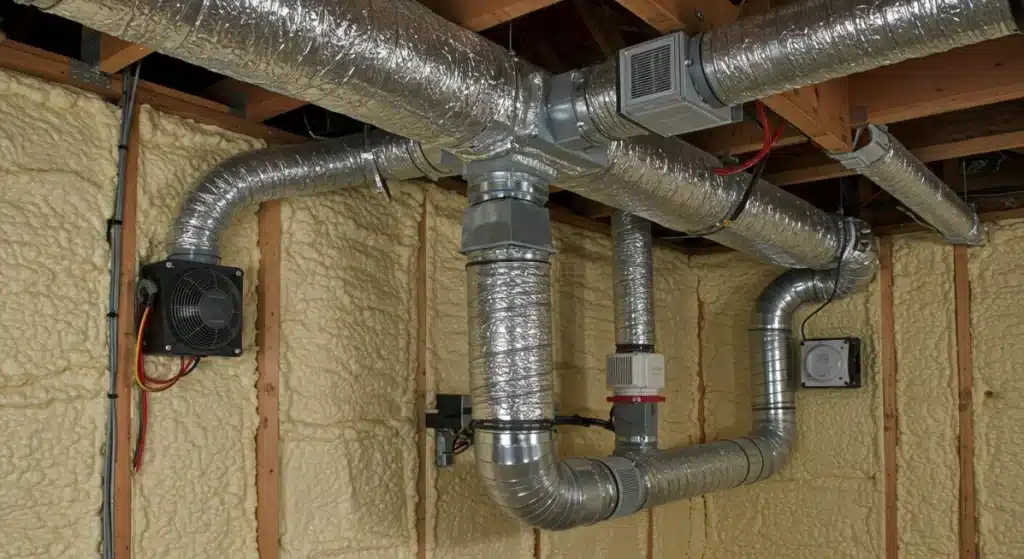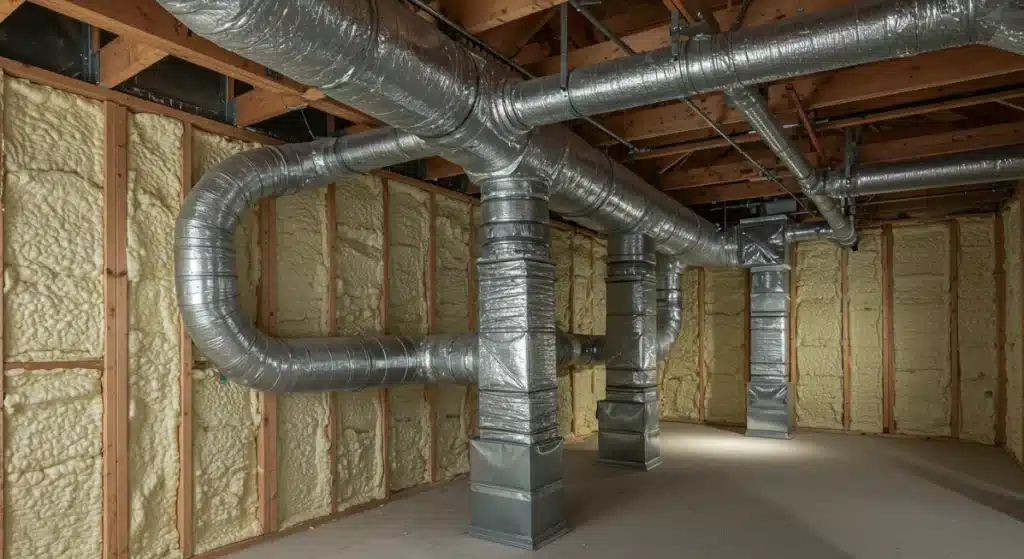Proper ventilation after spray foam insulation is critical to maintaining indoor air quality, managing moisture, and ensuring the material performs as intended. Without adequate airflow, buildings can trap off-gassed chemicals, create condensation issues, and compromise long-term structural health.
In Kerman, CA, where temperatures swing from hot, dry summers to cooler, damp winters, balanced ventilation becomes more than a technical consideration it’s essential for both occupant safety and building longevity. This guide outlines the functional role of ventilation, presents technical comparisons, and offers localized insight based on field experience.
Supreme Spray Foam Fresno brings firsthand experience managing insulation challenges in California’s Central Valley. This article shares field-based guidance grounded in building science and local installation experience.
How Ventilation Supports Spray Foam Performance
Spray foam creates an air seal that significantly reduces uncontrolled airflow. However, this seal also limits natural air exchange. Proper mechanical ventilation addresses this gap by managing air exchange deliberately, avoiding stagnant or contaminated air.
Key Functions of Post-Installation Ventilation
- Controls moisture buildup in closed spaces (attics, crawl spaces)
- Prevents indoor air quality degradation from chemical off-gassing
- Maintains energy efficiency by regulating indoor temperature and humidity
- Reduces condensation risks that lead to mold, mildew, or wood rot
Bonus Tip
In closed-cell spray foam applications within unvented attics, it’s best practice to install an energy recovery ventilator (ERV) or heat recovery ventilator (HRV) to manage indoor air quality without sacrificing energy efficiency.
Climate Considerations in Kerman, CA
Kerman’s semi-arid climate presents unique challenges. The intense summer heat combined with mild winter humidity requires ventilation strategies that adapt to seasonal shifts.
- In summer: Trapped heat without airflow can degrade insulation efficiency
- In winter: Sealed environments increase the risk of condensation and microbial growth
Local Ventilation Strategy Checklist
- Use mechanical ventilation for sealed attics
- Ensure crawl space dehumidification if foam is applied to ground-facing surfaces
- Integrate passive vents only if consistent airflow is possible year-round
Ventilation Options Compared
| Ventilation Type | Best Use Case | Pros | Cons |
|---|---|---|---|
| Passive Vents | Mild climates with airflow | No energy required, low cost | Ineffective in sealed environments |
| Mechanical Ventilation | Sealed attics/crawl spaces | Controlled air exchange | Higher installation/operating costs |
| Energy Recovery Ventilator (ERV) | Homes with foam-sealed envelopes | Balances air quality and energy use | Requires routine maintenance |
| Dehumidifier + Exhaust Fan | Crawl spaces, humid zones | Moisture control, simple setup | Limited to humidity control |
Technical Data for Ventilation After Foam Installation
| Parameter | Recommended Range/Spec | Notes |
|---|---|---|
| Indoor Relative Humidity | 30%-50% | Maintains comfort and mold prevention |
| ACH (Air Changes per Hour) | 0.35 minimum (ASHRAE Standard 62.2) | Required for acceptable indoor air quality |
| VOC Off-gassing Period | 24-72 hours post-installation | Depends on foam type and curing conditions |
| Ventilation Equipment Sizing | Based on home size and insulation coverage | Sizing formulas available from HVAC manufacturers |

Verified Industry Data Points
- A 2023 study by the Building Science Corporation found that improperly ventilated sealed attics in hot-dry climates showed a 27% increase in indoor moisture accumulation.
- According to ASHRAE, buildings with controlled mechanical ventilation systems maintain 35% more consistent humidity levels year-round (ASHRAE Journal, March 2024).
- EPA Indoor Air Quality data confirms that VOC levels spike 200%-400% in unventilated homes after foam insulation without adequate curing and airflow (EPA IAQ Report, 2023).
Things to Consider Before Making a Decision
- Building Age and Structure: Older homes may need structural reinforcement before installing closed-cell foam and ventilation equipment.
- Existing HVAC Setup: Check if the current system can accommodate additional ventilation loads.
- Occupant Sensitivities: If residents have respiratory conditions, enhanced air filtration may be necessary.
- Budget and Maintenance Commitment: Mechanical systems require upfront investment and ongoing maintenance.
Services Supreme Spray Foam Fresno Provides for This Application
- Attic Insulation: Installation and retrofit services designed for both vented and unvented attics.
- Closed Cell Spray Foam Insulation: High-density insulation with air and moisture barrier properties.
- Crawl Space Spray Foam Insulation: Effective sealing combined with moisture control strategies.
- Spray Foam Repairs: Correction of improperly applied foam that may hinder ventilation performance.
Common Questions Before Choosing a Ventilation Setup
How soon can ventilation systems be used after spray foam installation?
Begin mechanical ventilation once the foam has fully cured—typically within 24-72 hours.
What signs suggest poor post-installation ventilation?
Lingering odors, visible condensation, or elevated humidity are common indicators.
Is it possible to retrofit ventilation in a sealed attic?
Yes, mechanical systems like HRVs or ERVs can be added post-insulation with proper ducting.
Are all homes with spray foam required to have ventilation?
Yes, if the foam creates a sealed envelope. Natural air exchange alone is insufficient in sealed structures.
Get Expert Insulation Guidance
For specific ventilation strategies tailored to your property in Kerman, CA, contact:
Supreme Spray Foam Fresno Phone: (559) 545-0800 Email: [email protected]
Discuss your insulation goals with technicians experienced in Central Valley climates and modern spray foam systems.
FAQ About Maintaining Ventilation After Spray Foam
How often should ventilation systems be serviced?
At least annually. Replace filters and inspect ducting every 6-12 months.
Can DIY fans substitute for mechanical ventilation?
No. DIY setups rarely meet air change standards or moisture control requirements.
What’s the lifespan of a ventilation system installed for foam insulation?
Typically 10-15 years with routine maintenance.
How does weather impact ventilation settings?
Settings should adjust seasonally to manage temperature and humidity efficiently.
Do spray foam fumes linger without proper ventilation?
Yes. VOCs can remain concentrated without forced air circulation during and after curing.


